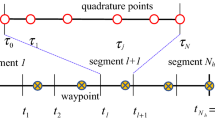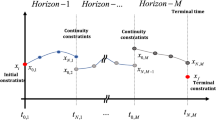Abstract
This paper intends to propose new inverse simulation techniques to cope with the numerical stability and accuracy problems frequently encountered with the integration inverse simulation methods widely used today. To achieve this, the pseudo-spectral method is adopted as a time integrator of the aircraft motion equations. In addition, the quasi-Newton and fixed-point iterative methods are applied to solve the resultant nonlinear algebraic equations in an efficient manner. These algorithms are integrated into a moving horizon framework to guarantee fast numerical convergence. The proposed methods are applied to the analyses of rotorcraft aggressive maneuvers such as popup, pirouette, and depart/abort mission-task-elements defined in the rotorcraft handling qualities requirements, ADS-33E-PRF. Numerical properties of the proposed methods are thoroughly investigated to clarify the effect of the numbers of quadrature nodes and time-horizon segments, and the level of maneuver aggressiveness on the robustness and efficiency of the analyses. Numerical efficiency and robustness of the present method are identified using specially designed performance measures such as the number of iterations to obtain a converged solution, functional residuals at the final solutions, and the variation of the adaptive relaxation factor. The results show that the present approach can provide extremely fast solutions of the inverse simulation problems and presents strong robustness to the level of maneuver aggressiveness, long-term simulation, and solution control parameters. Therefore, it is worthwhile to use the present techniques as one of the inverse simulation methods.











Similar content being viewed by others
References
Murray-Smith DJ (2000) The inverse simulation approach: a focused review of methods and applications. Math Comput Simul 53:239–247
Thomson DG, Bradley R (2006) Inverse simulation as a tool for flight dynamics research—principles and applications. Progress Aerosp Sci 42:174–210. https://doi.org/10.1016/j.paerosci.2006.07.002
Lu L, Murray-Smith DJ, Thomson DG (2008) Issues of numerical accuracy and stability in inverse simulation. Simul Model Pract Theory 16:1350–1364. https://doi.org/10.1016/j.simpat.2008.07.003
Celi R (2000) Optimization-based inverse simulation of a helicopter slalom maneuver. J Guid Control Dyn 23(2):289–297. https://doi.org/10.2514/2.4521
Avanzini Giulio, de Matteis Guido, de Socio Luciano M (1999) Two-timescale-integration method for inverse simulation. J Guid Control Dyn 22(3):395–401. https://doi.org/10.2514/2.4410
Brenan KE, Campbell SL, Petzold LR (1996) Numerical solution of initial-value problems in differential-algebraic equations. Society for Industrial and Applied Mathematics, 1996, pp 157–170. (ISBN: 978-0-89871-353-4)
Ascher UM, Petzold LR (1998) Computer methods for ordinary differential equations and differential-algebraic equations. Society for Industrial and Applied Mathematics, 1998, pp 231–253. (ISBN: 978-0-898714-12-8)
Hess RA, Gao C, Wang SH (1991) A generalized technique for inverse simulation applied to aircraft manoeuvres. J Guid Control Dynamics 14:920–926. https://doi.org/10.2514/3.20732
Kim C-J, Sung S (2015) Efficient spline transcription techniques for nonlinear optimal control analyses using a pseudospectral framework. IEEE Trans Control Syst Technol 2015:15. https://doi.org/10.1109/TCST.2014.2346994
Kim C-J, Sung SK, Park SH, Jung SN, Park TS (2014) Numerical time scale separation for nonlinear optimal control analyses with applications to rotorcrafts. AIAA J Guid Control Dyn 37(2):658–673. https://doi.org/10.2514/1.59557
Argyros Ioannis K (2009) On a class of Newton-like methods for solving nonlinear equations. J Comput Appl Math 228(1):115–122. https://doi.org/10.1016/j.cam.2008.08.042
Popescu Ovidiu (2007) Picard iteration converges faster than Mann iteration for a class of quasi-contractive operators. Math Commun 12:195–202. https://doi.org/10.1155/S1687182004311058
Yun YH, Kim CJ, Shin KC, Yang CD, Cho IJ (2012) Building the flight dynamic analysis program, HETLAS, for the development of helicopter FBW system. 1st Asian Australian rotorcraft forum and exhibition
Kim CJ, Shin KC, Yang CD, Cho IJ (2012) Interface features of flight dynamic analysis program, HETLAS, for the development of helicopter FBW system. 1st Asian Australian rotorcraft forum and exhibition
Anon, Handling qualities requirements for military rotorcraft. Aeronautical design standard, ADS-33E-PRF, United States army aviation and troop command, March 2000
Kim C-J, Lee DH, Hur SW, Sung S (2016) Fast and accurate analyses of spacecraft dynamics using implicit time integration techniques. Int J Control Autom Syst 12(2):524–539. https://doi.org/10.1007/s12555-014-0486-5
Thomson Douglas G, Bradley Roy (1997) Mathematical definition of helicopter maneuvers. J Am Helicopter Soc 42(4):307–309. https://doi.org/10.4050/JAHS.42.307
Kim CJ, Hur SW (2017) Ko JS (2017) On the use of finite rotation angles for spacecraft attitude control. Int J Aeronaut Space Sci 18(2):300–314. https://doi.org/10.5139/IJASS.2017.18.2.300
Acknowledgements
This work was conducted at High-Speed Compound Unmanned Rotorcraft (HCUR) research laboratory with the support of Agency for Defense Development (ADD).
Author information
Authors and Affiliations
Corresponding author
Additional information
Publisher's Note
Springer Nature remains neutral with regard to jurisdictional claims in published maps and institutional affiliations.
Rights and permissions
About this article
Cite this article
Kim, CJ., Lee, D.H. & Hur, S.W. Efficient and Robust Inverse Simulation Techniques Using Pseudo-Spectral Integrator with Applications to Rotorcraft Aggressive Maneuver Analyses. Int. J. Aeronaut. Space Sci. 20, 768–780 (2019). https://doi.org/10.1007/s42405-019-00160-x
Received:
Revised:
Accepted:
Published:
Issue Date:
DOI: https://doi.org/10.1007/s42405-019-00160-x




